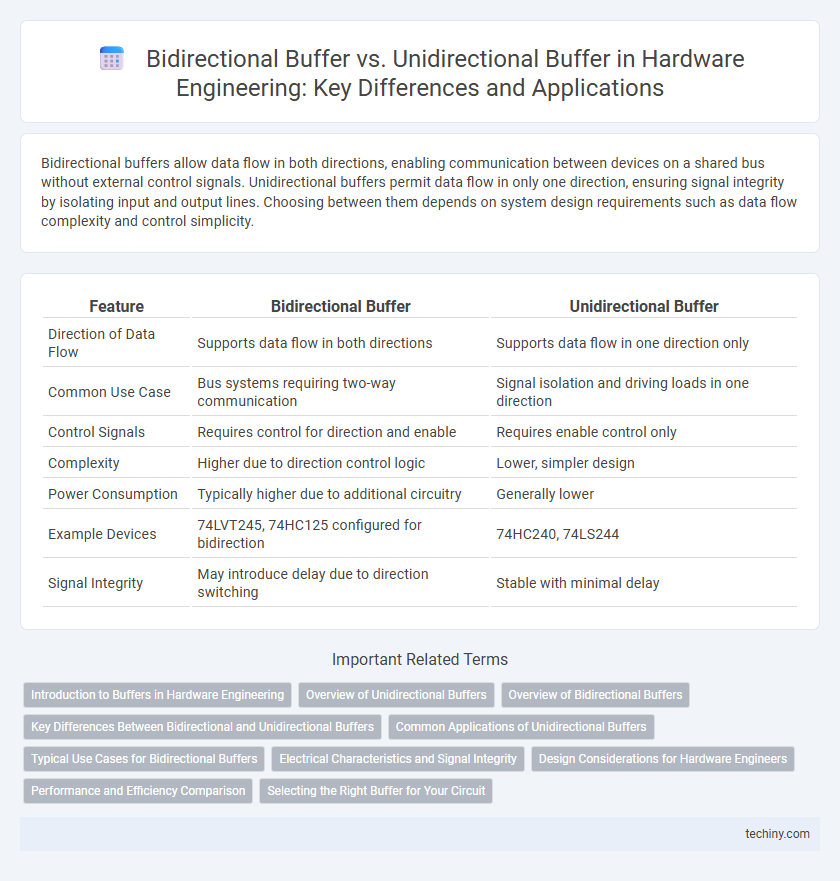Bidirectional buffers allow data flow in both directions, enabling communication between devices on a shared bus without external control signals. Unidirectional buffers permit data flow in only one direction, ensuring signal integrity by isolating input and output lines. Choosing between them depends on system design requirements such as data flow complexity and control simplicity.
Table of Comparison
| Feature | Bidirectional Buffer | Unidirectional Buffer |
|---|---|---|
| Direction of Data Flow | Supports data flow in both directions | Supports data flow in one direction only |
| Common Use Case | Bus systems requiring two-way communication | Signal isolation and driving loads in one direction |
| Control Signals | Requires control for direction and enable | Requires enable control only |
| Complexity | Higher due to direction control logic | Lower, simpler design |
| Power Consumption | Typically higher due to additional circuitry | Generally lower |
| Example Devices | 74LVT245, 74HC125 configured for bidirection | 74HC240, 74LS244 |
| Signal Integrity | May introduce delay due to direction switching | Stable with minimal delay |
Introduction to Buffers in Hardware Engineering
Buffers in hardware engineering serve as essential components for managing signal integrity and data flow between different circuit stages. Unidirectional buffers allow data transmission in a single direction, ensuring stable timing and isolation, while bidirectional buffers support data flow in both input and output directions, enabling more flexible communication in bus architectures. The selection between bidirectional and unidirectional buffers depends on circuit design requirements such as signal directionality, control complexity, and overall system architecture.
Overview of Unidirectional Buffers
Unidirectional buffers in hardware engineering enable signal transmission in a single, fixed direction, providing controlled data flow and isolation between circuit components to prevent backflow or interference. These buffers are essential in scenarios such as data buses or signal driving, where consistent and reliable propagation of electrical signals is required. Their design enhances signal integrity and reduces noise, making them critical for high-speed digital systems.
Overview of Bidirectional Buffers
Bidirectional buffers enable data flow in both directions between components, essential for systems requiring two-way communication, such as bus interfaces in microprocessors. These buffers use control signals to toggle between input and output modes, ensuring signal integrity and timing coordination. Unlike unidirectional buffers that allow data transfer only one way, bidirectional buffers optimize hardware design by reducing the number of physical lines and enhancing system flexibility.
Key Differences Between Bidirectional and Unidirectional Buffers
Bidirectional buffers allow data flow in both directions between components, enabling signal transmission and reception through the same pathway, while unidirectional buffers restrict data flow to a single direction only. In hardware engineering, bidirectional buffers typically incorporate tri-state logic to manage direction control, whereas unidirectional buffers rely on straightforward enable signals to permit data passage. The choice between these buffers impacts circuit complexity, signal integrity, and communication flexibility in designs such as microcontroller interfaces and memory buses.
Common Applications of Unidirectional Buffers
Unidirectional buffers are widely used in digital circuits to drive signals from a single source to multiple inputs, ensuring signal integrity and preventing loading effects. Common applications include data buses in microprocessors, memory address lines, and control signals where signal direction is fixed and predictable. These buffers enhance performance in environments requiring signal amplification or isolation without the complexity of handling bidirectional data flow.
Typical Use Cases for Bidirectional Buffers
Bidirectional buffers are commonly used in data buses where signals need to flow both to and from a microcontroller or processor, enabling efficient communication between devices. They facilitate bidirectional data transfer in memory buses, I2C interfaces, and parallel port connections by controlling the direction of data flow without signal degradation. Unlike unidirectional buffers, which only allow data in one direction, bidirectional buffers are essential for applications requiring dynamic direction control and bus contention management.
Electrical Characteristics and Signal Integrity
Bidirectional buffers enable data flow in both directions with high impedance state control, enhancing signal integrity by reducing reflection and crosstalk, whereas unidirectional buffers permit signal transmission in only one direction, offering simpler electrical characteristics but limited flexibility. The electrical characteristics of bidirectional buffers include stronger drive capability and configurable output enable, which improve noise margins and minimize signal distortion in complex hardware designs. Unidirectional buffers typically exhibit lower propagation delay and power consumption, making them suitable for simpler circuits that do not require signal reversal or bidirectional data flow.
Design Considerations for Hardware Engineers
Design considerations for hardware engineers involve signal integrity, power consumption, and complexity when choosing between bidirectional and unidirectional buffers. Bidirectional buffers require careful control logic to handle direction switching and prevent bus contention, while unidirectional buffers offer simpler design and predictable data flow but lack flexibility. Engineers must evaluate system requirements, including data flow control, propagation delay, and interface compatibility, to determine the optimal buffer type for efficient hardware design.
Performance and Efficiency Comparison
Bidirectional buffers enable data flow in both directions, improving efficiency in bus systems by reducing the need for multiple unidirectional lines, thus enhancing performance in complex hardware communication. Unidirectional buffers typically offer faster signal propagation due to their simpler design but require additional components to handle reverse data flow, which can increase latency and power consumption. In high-performance hardware engineering, bidirectional buffers optimize resource usage and minimize circuit complexity, while unidirectional buffers may deliver lower latency in single-direction data paths.
Selecting the Right Buffer for Your Circuit
Selecting the right buffer for your circuit depends on data flow requirements and signal integrity needs. Bidirectional buffers enable data transmission in both directions, making them ideal for bus systems with shared lines, while unidirectional buffers provide signal isolation and amplification in a single direction, benefiting point-to-point communication. Consider timing constraints, voltage levels, and load capacitance to optimize performance and ensure proper signal integrity in your hardware design.
Bidirectional buffer vs Unidirectional buffer Infographic

 techiny.com
techiny.com